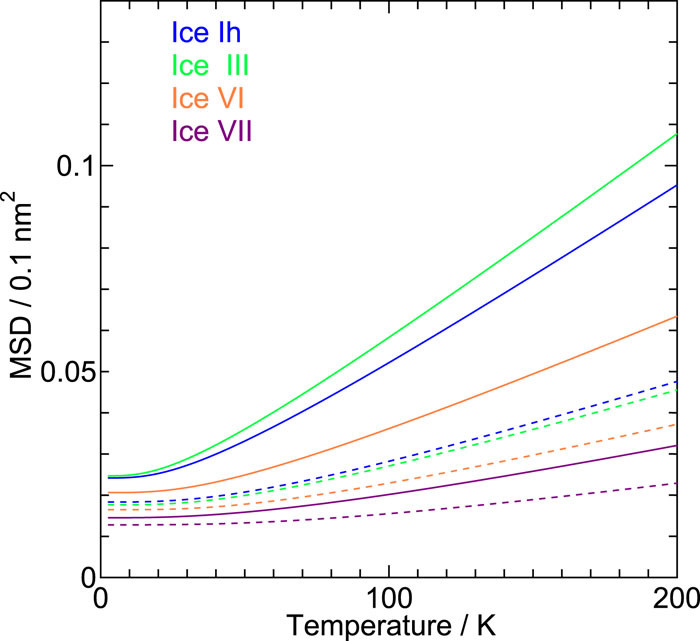TYM2020
Hideki Tanaka, Takuma Yagasaki, and Masakazu Matsumoto
On the role of intermolecular vibrational motions for ice polymorphs II: Atomic vibrational amplitudes and localization of phonons in ordered and disordered ices
J. Chem. Phys. 152, 074501 (2020).
We investigate the vibrational amplitudes and the degree of the phonon localization in 19 ice forms, both crystalline and amorphous, by a quasi-harmonic approximation with a reliable classical intermolecular interaction model for water. The amplitude in the low pressure ices increases with compression, while the opposite trend is observed in the medium and high pressure ices. The amplitude of the oxygen atom does not differ from that of hydrogen in low pressure ices apart from the contribution from the zero-point vibrations. This is accounted for by the coherent but opposite phase motions in the mixed translational and rotational vibrations. A decoupling of translation-dominant and rotation-dominant motions significantly reduces the vibrational amplitudes in any ice form. The amplitudes in ice III are found to be much larger than any other crystalline ice form. In order to investigate the vibrational mode characteristics, the moment ratio of the atomic displacements for individual phonon modes, called the inverse participation ratio, is calculated and the degree of the phonon localization in crystalline and amorphous ices is discussed. It is found that the phonon modes in the hydrogen-ordered ice forms are remarkably spread over the entire crystal having propagative or diffusive characteristic, while many localized modes appear at the edges of the vibrational bands, called dissipative modes, in the hydrogen-disordered counterparts. The degree of localization is little pronounced in low density amorphous and high density amorphous due to disordering of oxygen atoms.
結晶性及び非晶質の19種類の氷の振動振幅とフォノン局在の程度を、信頼性の高い古典的な水の分子間相互作用モデルを用いた擬似ハーモニック近似により調べた。低圧氷では圧縮に伴って振幅が増加するが、中高圧氷ではその逆の傾向が観測された。低圧氷中の酸素原子の振幅は、ゼロ点振動の寄与を除けば、水素原子の振幅と変わらない。これは並進振動と回転振動が混在しており、コヒーレントではあるが逆位相の運動をしているためである。並進優位の運動と回転優位の運動がデカップリングされることで、どのような形の氷でも振動振幅が大幅に減少することがわかった。その結果、氷IIIの振動振幅は他の結晶氷と比較して非常に大きいことがわかった。振動モードの特性を調べるために、逆参加比と呼ばれる個々のフォノンモードの原子変位のモーメント比を計算し、結晶氷及びアモルファス氷におけるフォノンの局在化の程度を議論した。その結果、水素秩序氷のフォノンモードは、伝播性や拡散性を持って結晶全体に広がっているのに対し、水素秩序氷のフォノンモードは散逸性モードと呼ばれる振動帯の端に局在していることが明らかになった。低密度アモルファスや高密度アモルファスでは、酸素原子の無秩序化により局在化の度合いはあまり顕著ではないが、低密度アモルファスや高密度アモルファスでは、酸素原子の無秩序化により局在化の度合いが顕著になっている。(DeepLによる機械翻訳)

research papers paper2020 water ice clathratehydrate